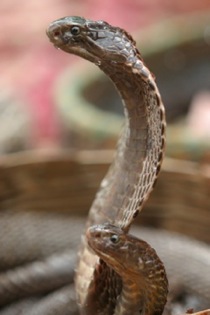The venom-spitting dinosaur in
Jurassic Park may have been fictional, but in a great case of life imitating art, scientists have discovered evidence of a real venomous dinosaur that walked the earth in China over 120 million years ago.
Sinornithosaurus is the first confirmed venomous dinosaur, but there is evidence that venom is even older than this most recent discovery--that creatures from up to 500 million years ago could also have been venomous. These ancient venomous creatures are giving us reason to believe that, evolutionarily speaking,
not being venomous may actually be more noteworthy than being venomous.
David Burnham, a paleontologist at the Kansas University Natural History Museum, was hunting for raptor fossils in rural China when he and his colleagues stumbled across a new fossil skeleton with grooved teeth and an inexplicable gap in its skull. They puzzled over what these two clues could mean. And then one day, while examining the skulls of venomous
komodo dragons, it suddenly clicked. The cavities in the raptor skull very closely resembled areas in the komodo dragon skull reserved for their venom glands. Burnham began to wonder, was it possible that this ancient raptor was also venomous?

My, what big teeth you have! The Sinornithosaurus fossil specimen bares its teeth. Image courtesy David Burnham.
|
Further investigation revealed that everything
Sinornithosaurus (the newly named raptor species) would need to be venomous was there. The spaces in the skull would have made room for prominent venom glands, along with a drainage canal leading into the mouth and muscles to help pump out the venom. But this dinosaur's venom-delivery mechanism was rather primitive. Unlike many modern snakes with long fangs in the front of their mouths that can forcefully eject venom at their prey (remember
spitting cobras?),
Sinornithosaurus had teeth with grooves for delivering venom that sat at the back of its mouth. Burnham suspects that over evolutionary time, tooth material closed in around the groove and migrated towards the front of the mouth, leading to something more closely resembling a cobra's fangs. The grooved teeth mean that unlike its fictional Jurassic Park counterpart,
Sinornithosaurus had to chew the venom into its prey, probably using it more as a stunning tool than a killing one. A handful of modern snakes, unsurprisingly called
"rear-fanged snakes," have retained the
Sinornithosaurus-style grooved teeth.
Discoveries like
Sinornithosaurus give scientists more decisive clues into the evolutionary history of venom. But we have reason to believe that venom is much older than even the dinosaurs. The conodont, an eel-like creature that lived almost 500 million years ago, had the same kinds of
grooved teeth found in
Sinornithosaurus and other primitive venomous creatures. And the evolutionary influence of the conodont is far from slight: it gave rise to all fish and most vertebrates.

















Recent Comments